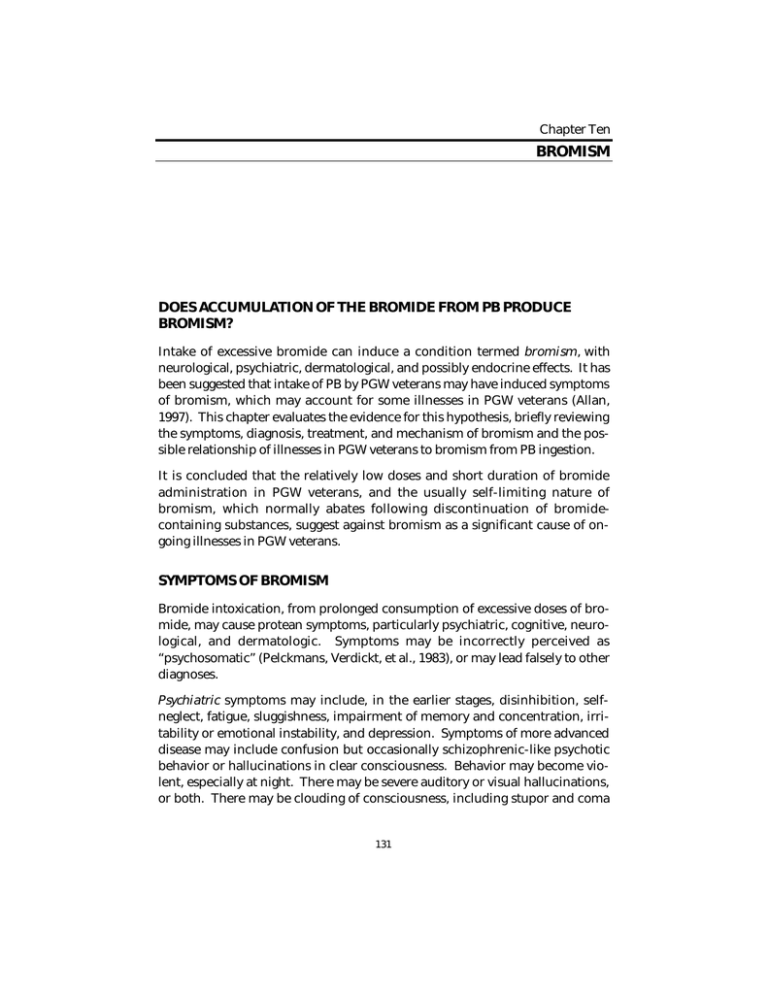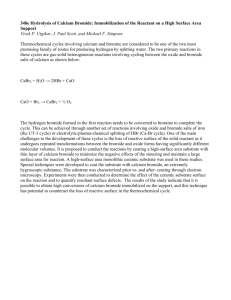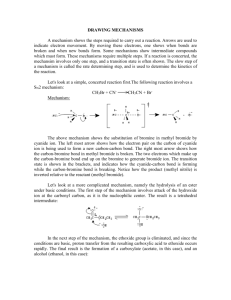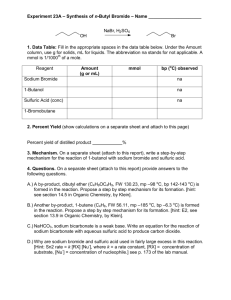BROMISM DOES ACCUMULATION OF THE BROMIDE FROM PB PRODUCE BROMISM?
advertisement

Chapter Ten BROMISM DOES ACCUMULATION OF THE BROMIDE FROM PB PRODUCE BROMISM? Intake of excessive bromide can induce a condition termed bromism, with neurological, psychiatric, dermatological, and possibly endocrine effects. It has been suggested that intake of PB by PGW veterans may have induced symptoms of bromism, which may account for some illnesses in PGW veterans (Allan, 1997). This chapter evaluates the evidence for this hypothesis, briefly reviewing the symptoms, diagnosis, treatment, and mechanism of bromism and the possible relationship of illnesses in PGW veterans to bromism from PB ingestion. It is concluded that the relatively low doses and short duration of bromide administration in PGW veterans, and the usually self-limiting nature of bromism, which normally abates following discontinuation of bromidecontaining substances, suggest against bromism as a significant cause of ongoing illnesses in PGW veterans. SYMPTOMS OF BROMISM Bromide intoxication, from prolonged consumption of excessive doses of bromide, may cause protean symptoms, particularly psychiatric, cognitive, neurological, and dermatologic. Symptoms may be incorrectly perceived as “psychosomatic” (Pelckmans, Verdickt, et al., 1983), or may lead falsely to other diagnoses. Psychiatric symptoms may include, in the earlier stages, disinhibition, selfneglect, fatigue, sluggishness, impairment of memory and concentration, irritability or emotional instability, and depression. Symptoms of more advanced disease may include confusion but occasionally schizophrenic-like psychotic behavior or hallucinations in clear consciousness. Behavior may become violent, especially at night. There may be severe auditory or visual hallucinations, or both. There may be clouding of consciousness, including stupor and coma 131 132 Pyridostigmine Bromide (Horowitz, 1997; Fried and Malek-Ahmadi, 1975; Wacks, Oster, et al., 1990; Carney, 1973). Neurological abnormalities of “all kinds” occur, including headache, tremor, slurred speech, spontaneous movements, incoordination, ataxia (abnormal gait), tendon reflex changes (increased or decreased reflexes), and extensor plantar responses (abnormal reflexes that signify “upper motor neuron” disease, disease in the brain or spinal cord that affects nerve signaling to the muscles) (Horowitz, 1997; Fried and Malek-Ahmadi, 1975; Wacks, Oster, et al., 1990; Carney, 1973). Vision changes have included decreased visual acuity often in conjunction with enlarged and poorly reacting pupils; disturbances of color perception, photophobia (abnormal sensitivity to light), micropsia and macropsia (perception of things as smaller or larger than they are), blurring of vision, and the quite characteristic mydriasis (enlarged pupils) (Levin, 1960; Kunze, 1976). EEG: Generalized slowing of the EEG has been reported (Carney, 1973). Dermatologic: Some patients will develop “bromoderma,” an acne-like “papular” (raised) eruption of the face and hands (Horowitz, 1997; Wacks, Oster, et al., 1990); a “macular” (nonraised) rash may also be seen (Carney, 1973). In one case series, four of six bromism patients had abnormal pigmentation, usually of the sun-exposed areas (Carney, 1973). Acute bromism is seldom seen because the bromide ion is irritating to the GI tract and produces vomiting before sufficient blood levels can be reached to cause bromism from short-term use. However, chronic bromism may develop—bromide is excreted slowly through the kidney, giving it the opportunity to build up in the body through ongoing ingestion (Morgan and Weaver, 1969). DIAGNOSIS OF BROMISM Diagnosis of bromism is often difficult due to the protean manifestations of bromism, and physicians’ failure to consider bromism as a cause of illness. Above all, diagnosis requires “clinical suspicion”—that is, the physician must consider the diagnosis or it will be missed. Bromism was substantially more common prior to removal from the market of certain over-the-counter remedies high in bromide, such as Bromo-Seltzer and Miles Nervine (Wacks, Oster, et al., 1990); it was particularly common in the 1930s and 1940s but is substantially less so since the 1970s. Because of its relative rarity, physicians are less likely to consider bromism in the differential diagnosis, so that many cases may remain undiagnosed or misdiagnosed Bromism 133 (Horowitz, 1997). One report observes that in almost every case report in the literature, including their own, the diagnosis of bromism was delayed while other causes of illness, including acute psychiatric or neurological illness, were considered (Horowitz, 1997). Another observes that “Perhaps because he regards it as extinct, the family doctor almost invariably fails to recognize bromism, even when, as in four of my (six) cases, he was the source of the supply” (Carney, 1973). In the presence of clinical suspicion (typically arising from signs or symptoms of neurological or psychiatric disturbance without other identified cause), (1) a careful review of prescription and over-the-counter medications should be undertaken to elicit use of medications that may contain bromide. A dietary history may also be helpful; one report has implicated excessive consumption of colas containing brominated vegetable oil (Horowitz, 1997). Absence of identification of bromide-containing agents should not thwart further inquiry, as in some instances the source of bromide is never determined (Battin and Varkey, 1982); for this reason it has been suggested that bromide intoxication be considered “in the differential diagnosis of obscure, unusual, or refractory psychiatric symptomatology” (Battin and Varkey, 1982). (2) A chemistry panel should be obtained to evaluate presence of hyperchloremia, which may occur in the absence of a negative anion gap (Horowitz, 1997), and to allow calculation of the anion gap (Wacks, Oster, et al., 1990; Horowitz, 1997). Where suspicion directs, (3) serum bromide level should be secured (Wacks, Oster, et al., 1990). A serum bromide concentration above 50 mg/dL is considered confirmatory (Carney, 1973), and significant symptoms usually do not occur below this level (but see section on “Low-Level Bromism,” below). TREATMENT OF BROMISM The most important element of treatment is cessation of bromide exposure. Additional treatment of bromide toxicity has traditionally involved saline loading (administration of large quantities of sodium chloride in water, typically by vein), which enhances kidney excretion of bromide. The chloride ion from sodium chloride competes with and replaces the bromide ion throughout the body. While the usual half-life of bromide (the time for half the body’s complement of bromide to be eliminated) is 12 to 14 days (Horowitz, 1997), a half-life of 65 hours has been calculated with saline loading. Cases failing to respond to saline loading have been successfully treated with mannitol or “loop” diuretics (a type of diuretic, or water-excretion enhancing agent, that acts on a specific part of the kidney), and one report calculated a half-life of 1.65 hours with “diuresis,” using the agents mannitol and ethacrynic acid (Horowitz, 1997). Hemodialysis has been used to treat bromism. Calculated bromide halflives with hemodialysis in different case reports have been 1.78 hours (in a case 134 Pyridostigmine Bromide report from 1951) (Merrill and Weller, 1952), 0.9 hours, and 1.38 hours in a more recent case report (Horowitz, 1997). Hemodialysis led to prompt resolution of focal neurological signs in a patient who failed to respond to saline (sodium chloride solution) (Horowitz, 1997). Patients with a depressed mental status due to bromism, or with bromide levels in excess of 200 mg/dL (25 mmol/L) may not achieve nontoxic levels (without treatment) for almost a month and would require five days of saline loading to achieve levels below 50 mg/dL (6.3 mmol/L), the threshold of what is normally construed as the toxic level (Horowitz, 1997). Therefore, in these cases it may be appropriate to use hemodialysis to remove the bromide ion from the blood rather than relying on the kidney (Horowitz, 1997). CAUSES OF BROMISM Causes of bromism are reviewed here to allow the reader to evaluate the likelihood of interactions between PB and other agents that may contribute to bromism. Cases of bromism have been reported with consumption of bromidecontaining prescription and nonprescription medications, including PB in one reported case (in a patient with myasthenia gravis, receiving longer duration and higher-dose treatment than PGW veterans) (Wacks, Oster, et al., 1990), sleeping medications, and tonics; with consumption of cola that contains brominated vegetable oil; and with consumption of bromide-tainted well water (Fried and Malek-Ahmadi, 1975). Most cases represent one of three groups: organic bromides, bromoureides, and biotransformation of bromide compounds (Horowitz, 1997). “Organic bromides” include the salts of sodium, potassium, and ammonium bromide; these salts have been available since 1857, with wide use during the 1930s and 1940s as sleep aids and antiepilepsy drugs (Horowitz, 1997). In 1938, bromide sales in the United States were surpassed only by sales of aspirin (Horowitz, 1997). However, many patients admitted to psychiatric institutions were found to suffer from bromism from overuse of these products, rather than from the psychiatric illnesses for which they had been incorrectly diagnosed, and the use of these products thereafter decreased until they were withdrawn from the market in 1975. Widely cited culprits included the sedative Nervine, produced by Miles Laboratory, which contained all three bromide salts; and BromoSeltzer, which contained 3.2 milliequivalents per teaspoon (mEq/tsp) of sodium bromide (Horowitz, 1997). Since these agents were withdrawn from the market, bromism has been far less frequent. “Bromoureides” are sedative-hypnotics available primarily in Europe, including Bromisovalum (Bromural) and carbromal (Carbitral) (Horowitz, 1997). Occasional reports of bromism from Bromism 135 long-term overuse have been reported (Maes, Huyghens, et al., 1985). Finally, of particular relevance here, bromide released through the “biotransformation” of medications containing the bromide ion is an infrequent cause of bromism. PB and dextromethorphan bromide (used in cough medicine) have been reported to cause bromism. Anesthesia with the agent “halothane” will increase bromide levels, peaking at two to three days postanesthesia. Pesticide residues from common agricultural fumigants, such as “methyl bromide” and “ethylene dibromide,” may elevate the bromide content of vegetables, but bromide toxicity has not been reported from this source (Horowitz, 1997). MECHANISM OF BROMISM It is assumed that bromide acts by replacing part of the chloride in the body (Blumberg and Nelp, 1966). In spite of the use of bromides for their antiepileptic action for more than a century, we know little about the action of bromide on the cellular level in the CNS other than that it may influence synaptic processes by its action on the transport systems (Kunze, 1976), or by substituting for chloride ions in actions of neurotransmitters. (Neurotransmitters classically communicate by producing membrane voltage changes through the movement of ions, including chloride, through specialized ion channels associated with neurotransmitter receptors on the signal-receiving cell. For instance GABA, or gamma amino butyric acid, the chief inhibitory neurotransmitter in the brain, functions through specialized chloride ion channels (Allen and Albuquerque, 1987).) Regional cerebral blood flow, that is, blood flow to different parts of the brain, may also be altered with bromism. Regional cerebral blood flow was assessed in a case of bromide psychosis using radioactive xenon (133 Xe) inhalation (Berglund, Nielsen, et al., 1977). On the first exam, when the serum bromide level was 45 mEq/L (extremely high, within the potentially lethal range), the cerebral blood flow was reduced to approximately one-third of normal, with abnormal regional flow characterized by low flow in regions of the cortex, including frontal and parieto-occipital regions. Dialysis led to improvement in the clinical condition, and restoration of regional cerebral blood flow (Berglund, Nielsen, et al., 1977). Changes in regional cerebral blood flow— reflecting or perhaps influencing altered regional neuronal activity in the brain—could relate to symptoms of bromism. BROMIDE LEVELS THAT RESULT IN BROMISM Serum bromide levels at which toxic symptoms appear are extremely variable (see Table 10.1); nonetheless, symptoms are seldom seen at plasma concen- 136 Pyridostigmine Bromide Table 10.1 Bromide Blood Concentration and Toxicity mg/dL < 50 50–100 100–200 200–300 >300 mEq/L = mmol/L <6.3 6.3–12.5 12.5–25 25–37.5 >37.5 Toxicity “Therapeutic” Possible toxicity Usually serious toxicity Possible coma Possibly fatal SOURCE: Ellenhorn, Schonwald, et al., 1997. trations under 50 mg/dl (6.3 mEq/L); symptoms are commonly seen at concentrations between 50 and 100 mg/dl (6.3–12.5 mEq/L); and symptoms are almost invariable when the serum concentration exceeds 100 mg/dl (Ellenhorn, Schonwald, et al., 1997; Gaff, Rand, et al., 1969). At 200–300 mg/dl (25–37.5 mEq/L) coma may occur, and levels exceeding 300 mg/dl (37.5 mEq/L) may be lethal (Morgan and Weaver, 1969; Ellenhorn, Schonwald, et al., 1997), although mortality from bromism is low (Morgan and Weaver, 1969). Of note, chronic use of bromide-containing drugs may result in serum bromide levels capable of interfering with chloride measurements without causing signs or symptoms of overt bromide toxicity. In one reported case of a myasthenic patient taking a total daily dose of 360 mg of PB (four times the daily PGW dose, and 110.4 mg bromide per day) (Wacks, Oster, et al., 1990), this measurement problem occurred. The patient was admitted with symptoms of myasthenia (but no symptoms of bromism). The abnormal anion gap was noticed in the course of evaluation of the patient for symptoms of reduced muscle strength, facial weakness, and slurred speech, compatible with myasthenia undertreatment or overtreatment. Serum bromide was 8.1 mEq/L (64.8 mg/dL). A double-blind study has been performed in which several subjective and objective outcomes were evaluated following three months of bromide administration. Men and women receiving 0, 4, or 9 mg/kg/d of bromide (seven subjects in each group) for 12 weeks reported decreased ability to concentrate and increased sleepiness (among men only) who received bromide; and a statistically significant increase in several measures of thyroid function (among women only) (Sangster, Blom, et al., 1983). Mean plasma bromide at the end of treatment was 0.08, 2.14, and 4.30 mEq/liter in males; and 0.07, 3.05, and 4.93 mEq/liter for females, for the 0, 4, and 9 mg/kg/d groups, respectively. (The conversion is 8 mg/dL for 1 mmol/L, or 1 mEq/L). No changes were observed in measurements of hormones produced in the adrenals, the gonads, and the pituitary gland (Sangster, Blom, et al., 1983). Of note: A study in rats found a significant decrease in thyroid function among female rats. Other rodent studies have reported (1) that bromide behaves more Bromism 137 like iodine than like chlorine in the thyroid (iodine administration can induce hypo- or hyperthyroidism); and (2) that bromide can produce changes in thyroid hormones T4 and T3, in the absence of changes in thyroid-stimulating hormone (Vobecky and Babicky 1994; Vobecky, Babicky, et al., 1996a; Vobecky, Babicky, et al. 1996b; Velicky, Titlbach, et al., 1997a; Velicky, Titlbach, et al., 1997b; Velicky, Titlbach, et al., 1998). In humans, the action of PB in particular on thyroid-related hormones is well known, and PB is used in testing of certain thyroid hormone responses. It ordinarily enhances the release of a pituitary hormone, thyroid-stimulating hormone, in response to administration of a hypothalamic hormone, thyrotropin-releasing hormone (Coiro, Volpi, et al., 1998). LOW-LEVEL BROMISM It is said that bromism seldom produces symptoms at blood levels below 50 mg/dL (Ellenhorn, Schonwald, et al., 1997). Most reports note dramatic neuropsychiatric symptoms associated with markedly high serum levels of bromide. Only the Sangster study, described above systematically evaluated the dose of bromide at which more subtle symptoms may become manifest in a double-blind trial. This study suggested the possibility, requiring confirmation, that men may be subject to mild sleep abnormalities and concentration difficulties and women may develop thyroid abnormalities at serum levels slightly below this 50 mg/dL (Sangster, Blom, et al., 1983; however, these levels remain substantially higher than levels of bromide that would be expected from doses of PB given to PGW veterans. Several studies have cited instances of bromide toxicity at doses of serum bromide under those usually viewed as toxic (Sayed, 1976; Gerner, 1978), as low as 25 mg/dL (Battin and Varkey, 1982). Individual susceptibility varies greatly and it has been suggested that following prolonged intoxication serum levels may not accurately reflect nervous system involvement. (However, prolonged intoxication was quite unlikely to have characterized the PGW experience.) Moreover, toxic states may depend more on other factors. Suggested factors include the “general mental state,” “premorbid personality” (both may be reflections of prior neurochemical state), duration of ingestion, state of hydration, and electrolyte balance of the patient (Battin and Varkey, 1982; Whybrow and Ewing, 1966; Freedman, Kaplan, et al., 1978)). TIME-COURSE OF RESOLUTION OF BROMISM The untreated half-life of bromide (time for half the initial blood amount to be excreted) administered orally is approximately 12 days (Vaiseman, Koren, et al., 1986); the half-life with saline is several days (about 65 hours), and a half-life as 138 Pyridostigmine Bromide low as one hour has been reported with hemodialysis (see section on “Treatment”). Evidently there is no “slowly exchangeable” pool of bromide (bromide sequestered somewhere in the body where it is not readily eliminated); rather all bromide appeared to be “easily exchangeable” because adding a small amount of radiolabeled bromide (Br82) in a case of severe chronic bromide intoxication showed rapid and apparently complete equilibration of the stable and radioactive bromide (Blumberg and Nelp, 1966). The plasmaspecific activity (radiolabeled bromide in counts per minute, or “cpm,” divided by fraction of unlabeled bromide in mEq) remained constant as the plasma bromide decreased, and the bromide space (volume of distribution in liters) remained approximately constant). Most reported cases resolve promptly with treatment of bromism through saline diuresis (sodium chloride delivery with enhanced urination) or hemodialysis. However, several reports indicate instances of partial resolution with long-lasting sequelae (see section on “Long-Term Symptoms”). BROMISM DUE TO PB In one report, PB at doses of 60 mg three times daily plus 180 mg at bedtime (four times the daily PGW dose) was associated with a negative anion gap1 and a bromide level of 65.1 mg/dl (8.1 mEq/L) (Wacks, Oster, et al., 1990); although this bromide level is compatible with symptoms of bromism, no such symptoms were reported. Another report implicates PB in generation of bromism (Rothenberg, Berns, et al., 1990). However doses of PB administered in these ______________ 1 The “anion gap” (or difference between measured cations and measured anions) is calculated by subtracting the sum of anions (negatively charged ions of chloride and bicarbonate, in mEq/L, that are measured in the blood in a routine chemistry panel) from the major cation (positively charged ions of sodium, in mEq/L). The normal anion gap ranges from about 12 to 16 mEq/L. (An alternative strategy adds the potassium to the sodium prior to subtracting the chloride and bicarbonate, leading to a slightly different normal range). Because the anions and cations in the body are balanced—that is, total anions are equal in number to total cations in the blood— therefore measured anions (“MA”) plus unmeasured anions (“UA”) equals measured cations (“MC”) plus unmeasured cations (“UC”). Rearranging the equation, measured cations minus measured anions (the anion gap) is equal to unmeasured anions minus unmeasured cations: (MC–MA) = (UA–UC). Bromide might be thought to be an unmeasured anion, and is increased—so one might suppose that the anion gap would be increased compared to usual. However, bromide interferes with many or all existing measures of chloride and produces a (spurious) increase in the measured chloride. (Thus, bromide is in a sense actually measured, though as chloride, and not necessarily in 1:1 proportion to its presence.) The “ion selective method” for chloride evaluation (“potentiometry”) exhibits the greatest interference, while “colorimetry” (also called “photometry,” or the “thiocyanate method”) produces a lesser elevation of the reported chloride, and “coulometry” produces the least. Potentiometry may reveal a strongly negative anion gap, while a positive, normal or nearly normal anion gap may appear with the coulometry method (Wacks, Oster, et al., 1990). However, most major methods of chloride determination are affected by bromide (Elin, Robertson, et al., 1981). Bromism 139 reports were substantially higher than in PGW veterans, and such reports are rare. LONG-TERM SYMPTOMS Persistent Symptoms Following Bromism Several case reports of bromism have noted the presence of persistent symptoms attributed to bromism that lasted beyond the time of elevated blood bromide levels.2 Such case reports are rare, and it is difficult to exclude the possibility of concurrent pathology leading to persistent symptoms. That is, the residual symptoms, associated with observed cerebral atrophy, a seizure disorder, and a history of head trauma in the second case, could have had an independent cause. Neither can one exclude an effect or interaction of bromide with other drugs given prior to or during treatment, including in these instances the treatment agents clomethiazol or mercaptomerin. However, persistent effects resulting from bromism must be considered a possibility. Long-term effects from chronic regional cerebral blood flow abnormalities or from chronic chloride ion channel alterations (see “Causes of Bromism,” above) could be hypothesized to relate to persisting effects. It is conceivable, but certainly not demonstrated, that prolonged hypoperfusion of selected brain regions with ongoing bromide ______________ 2 Cases of persistent symptoms attributed to bromism: In one case, a 40-year-old woman initially showed “typical symptoms and signs of chronic bromide intoxication,” including psychiatric symptoms, such as irritability and lethargy, a 30-pound weight loss, hand tremor, and minor gait difficulties while taking about 5 gm per day of bromdiathylacetylcarbamid as a sedative (Kunze, 1976). She developed a delirious state (fluctuating mental function) when the bromide-containing drug was stopped by a physician. (Such transient delirium has been not infrequently reported with bromide discontinuation.) Although the psychiatric symptoms cleared rapidly, the neurological state deteriorated; the most severe neurological state appeared 8 to 10 days after the drug was stopped, including a resting tremor of the head and upper extremities and a marked cerebellar dysfunction with severe generalized incoordination (ataxia) but without nystagmus. (Nystagmus is a rhythmic oscillation of the eyeballs that occurs, for a few cycles, with gaze far to one side, but is prolonged with some kinds of nervous system dysfunction.) The patient received a drug called Clomethiazol during this period, but no other CNS-toxic drugs, and all neuropsychiatric symptoms were assumed to result from bromism and the cessation of the bromide containing agent. A year after discharge from the hospital, despite some initial improvement, the patient was left with a mild dysarthric speech (altered speech production caused by difficulty performing the muscle movement involved in speech), a mild gait ataxia, and a moderate ataxia of her upper extremities so that writing was almost impossible. She had a marked constriction of her visual fields (that is, a loss of peripheral vision) which could be verified by formal testing (Kunze, 1976). In the second case, a 60-year-old woman who had taken at least four teaspoons daily of triple bromide elixir for seven years, prescribed for a post-head-injury seizure condition, was hospitalized with bizarre behavior and hallucinations and a serum bromide concentration of 44.6 mEq/l. She was treated with isotonic saline and daily injections of mercaptomerin sodium (Thiomeri), but even after serum bromide levels fell to below 4 mEq/L and her mental state improved considerably, a significant deficit in orientation and memory remained. A pneumoencephalogram showed bilateral cerebral atrophy, which was presumed responsible for the residual abnormalities. 140 Pyridostigmine Bromide intoxication could engender permanent changes, perhaps with frank loss of neurons or supporting glia, or reduction in synaptic contacts. It is also possible that chronic substitution of bromide for chloride could affect chloride channel behavior in the CNS, with consequent altered neurotransmission, leading to compensatory changes in neurotransmitter regulation. Still, such changes would be unlikely to be produced with short-term use of relatively low doses of bromide, such as occurred in PGW veterans taking PB. Persistent Symptoms Following Bromisovalum Bromisovalum has been reported to cause toxic symptoms, which in some instances are prolonged or permanent. In one series of eight cases with persistent symptoms, initial bromide levels were 105–169 mg/dl (with a mean of 140 mg/dl) (Harenko, 1967). The principal symptom was gait ataxia in all cases, with difficulty maintaining balance and staggering (8/8); then dysarthria (difficulty producing the muscle actions of speech) (6/8), exaggerated deep tendon reflexes of lower limbs (4/8), nystagmus (1/8), positive Babinski reflex (a pathological reflex) (1/8), tongue deviation to one side (1/8), and auditory impairment (Harenko, 1967). Changes in the eye, as seen with an ophthalmoscope (“fundal” changes), and impaired vision had been previously reported as irreversible lesions caused by bromisovalum, but were not encountered in these cases. Compared to patients who achieved complete recovery from bromisovalum poisoning, no differences were established in age, sex, duration and degree of abuse, prior illness, serum bromide level, symptoms, and severity of the subacute phase. Factors speculated to predispose individuals to persistent symptoms were recurrence of severe intoxication states, poor nutritional and general condition, and overlong continuance of the toxic condition (Harenko, 1967). It has been suggested that persisting symptoms with bromisovalum may result not from bromide ion or bromisovalum itself, but from 3-methylbutyrylurea (a breakdown product) or its metabolites (Harenko, 1967). Nonetheless, similarities between symptoms with bromisovalum toxicity and with bromide intoxication are sufficient for a common mechanism to be operative. It is not possible to exclude a role for bromide in the two cases with symptoms that persisted long after elevated blood bromide levels would be presumed to be normal (or in the cases of prolonged symptoms with bromisovalum); nonetheless, these reports are rare and occurred in patients who ingested bromide at high doses for prolonged periods. Therefore, their experiences cannot be presumed to extend to PGW veterans who experienced low doses of bromide for brief periods. Bromism 141 BROMIDE INTERACTIONS There is wide variation in the level of blood bromide at which symptoms of bromism begin. Arteriosclerosis, alcoholism, dehydration, malnutrition, psychosis, or heart disease may reportedly cause an earlier onset of symptoms with lower blood levels (Morgan and Weaver, 1969). There is little information to assess whether other conditions or exposures occurring concurrently may cause bromide to induce a chronic condition, persisting beyond the time of high blood bromide levels. AMOUNT OF BROMIDE IN PB GIVEN TO PGW VETERANS 60 mg of PB as Mestinon (the commercially available form of PB in the United States) contains 18.4 mg (30.6 percent) of bromide (Wacks, Oster, et al., 1990). Therefore, the expected daily dose of bromide in PGW veterans receiving PB as a pretreatment adjunct, at 30 mg three times daily, is 27.6 mg/day of bromide. As the prior section indicates, even far higher doses (9 mg/kg/day, or about 630 mg/day—about 23 times the PGW dose) administered for much longer time (12 weeks, compared to usually under two weeks for PGW veterans) produce bromide levels of 4.3 mmol/L, or about 34.4 mg/dL, still well under the 50 mg/dL that is generally viewed as the lower bound for toxic effects. Thus doses and durations of treatment with PB in PGW personnel would be highly unlikely to reach toxic levels. Although there are reports of chronic bromide ingestion on the range of four times the PGW dose leading to potentially toxic bromide levels, because PGW veterans received lower doses of PB and seldom for more than very short periods, it is highly unlikely that bromism from PB was a substantial contributor to illness in most veterans. It is conceivable that some veterans may have received higher and/or more prolonged doses of PB (some report durations of PB usage as long as six months or report taking two pills with each dose) and also had especially high native susceptibility; even so this would imply development of bromism at lower doses of PB than have been reported, and this is unlikely to be a significant contributor to illnesses in PGW veterans. BROMISM AS A CAUSE OF PGW ILLNESSES Neurological and psychiatric symptoms, including memory loss, as well as dermatological symptoms, including rashes, are common to bromism and to illnesses in PGW veterans. Nonetheless, short-term use of PB, at 30 mg three times daily for periods seldom exceeding two weeks, would appear to be an unlikely cause of long-term illness due to bromism in PGW veterans, because the low daily dose of bromide administered and the short time period of admin- 142 Pyridostigmine Bromide istration make it exceedingly unlikely that toxic bromide levels would be reached unless unknown interactions with other exposures are at play. In clinical reports of bromism, symptoms have generally cleared quickly with clearance of bromide; exceptions have typically involved chronic use with high doses and perhaps repeated toxicity. The relatively long half-life of bromide in the absence of treatment for bromism (approximately 12 to 14 days) remains quite short in comparison to duration of symptoms reported by many veterans. Even extreme bromism would be expected to resolve spontaneously in a month or two after bromide-containing agents are discontinued; and myasthenics taking substantially higher doses of PB (e.g., 12 times as high) for much longer times have seldom been reported to experience bromism, even when serum bromide levels were elevated and anion gaps modified. In contradistinction to the acetylcholinergic effects of PB, which might be expected to differ for myasthenics and PGW veterans, no reason has been identified that would suggest that bromide metabolism should differ systematically between myasthenics and PGW service personnel. Thus, although it is conceivable that experience with a much larger population, as seen in the PGW, would unveil a hitherto unrecognized longer-term syndrome at low doses, it would be expected to affect a relative minority of subjects reporting continued illnesses following participation in the PGW. SCIENTIFIC RECOMMENDATIONS There is insufficient evidence to warrant placing a high priority on additional testing of bromism as a cause of long-term illnesses in PGW veterans. If studies on drug-drug or drug-chemical interactions are undertaken, using drug and chemical exposures in the PGW, addition of bromide to study regimens may be considered. (This may assist in unraveling relative contributions of AChE inhibition and bromide, if effects appear to involve PB as an interactant.) SUMMARY ANALYSIS Compatible exposure? Bromide exposure occurred in all veterans receiving PB; the cumulative bromide dose, however, appears too low to be consistent with bromism, based on a best reading of present literature. Compatible symptoms? Some ill veterans report some neuropsychiatric symptoms crudely compatible with symptoms of bromism Compatible relation of exposure to symptoms? Exposure to PB for longer durations and at higher doses would be more likely to produce bromism; how- Bromism 143 ever, seldom was the cumulative dose of PB received sufficient for production of bromism by our current understanding of bromism from decades of former use of bromide-containing agents. Disappearance of symptoms with a defined time-course after discontinuation of PB would be expected if bromism were the cause. This resolution of symptoms has not been widely reported. Thus, dose and time-course of exposure, and the relation to existence and time-course of illnesses, do not favor bromism as a cause.






